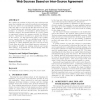1091 search results - page 110 / 219 » Swarming to rank for information retrieval |
IR
2011
13 years 4 months ago
2011
In this paper, we evaluate a number of machine learning techniques for the task of ranking answers to why-questions. We use TF-IDF together with a set of 36 linguistically motivate...
ISBRA
2011
Springer
13 years 17 days ago
2011
Springer
Abstract. Protein homology prediction is a crucial step in templatebased protein structure prediction. The functions that rank the proteins in a database according to their homolog...
CIKM
2009
Springer
14 years 1 months ago
2009
Springer
The nDCG measure has proven to be a popular measure of retrieval effectiveness utilizing graded relevance judgments. However, a number of different instantiations of nDCG exist, d...
WSDM
2010
ACM
14 years 6 months ago
2010
ACM
Many web documents are dynamic, with content changing in varying amounts at varying frequencies. However, current document search algorithms have a static view of the document con...
WWW
2010
ACM
14 years 4 months ago
2010
ACM
We consider the problem of deep web source selection and argue that existing source selection methods are inadequate as they are based on local similarity assessment. Specificall...

